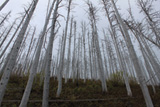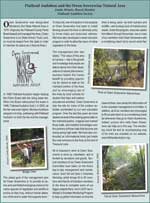“Those little nimble musicians of the air, that warble forth their curious ditties,
with which nature hath furnished them to the shame of art.”
- Isaak Walton, 1593-1683
Birds
Birds are, to differing degrees, sensitive to disturbances, fragmentation, and loss of habitat. They require specific habitat features to survive, including appropriate cover, nutritious food, and clean water. Because the watershed offers these things in abundance, there is no lack of feathered diversity in the Flathead. With approximately 277 regularly occurring species and another 42 rarities, 319 bird species make the watershed their permanent or part-time home.
The watershed provides an abundance of significant bird habitats from sweeping, open grasslands to dense, mature forests; from shallow grassy marshland to swift-moving streams. Forests opened by fire and logging meet the unique needs of several species of birds, as do the successional habitats that follow. Dead standing trees provide homes for cavity-nesting birds, where they find protection from weather and predators. Wetlands also supply important habitat for birds, particularly in grassland-dominated landscapes, and although much of this land has been altered or repurposed, there are several wetland areas now protected and managed to provide nesting and brood-rearing habitat.
 |
| Figure 2.63: Canada geese. Source: Karen Nichols |
Some resident birds that remain in the watershed year-round include great horned owl (Bubo virginianus) and northern pygmy-owls (Glaucidium gnoma); ruffed, dusky, and spruce grouse (Bonasa umbellus; Dendragapus obscurus; Falcipennis canadensis); red-breasted and pygmy nuthatches (Sitta canadensis; S. pygmyaea); mountain and black-capped chickadees (Poecile atricapillus; P. gambeli); and common ravens (Corvus corax). Other birds like the Townsend’s solitaire (Myadestes townsendi) remain in the watershed through the harsh winters, but move from higher to lower altitudes where food is more abundant and the weather is milder. One of the most visible birds found year-round in the foothills of the watershed is the wild turkey (Meleagris gallopavo)—which like the ring-necked pheasant (Phasianus colchicus) and gray partridge (Perdix perdix)—was introduced to the region but has flourished in and around agricultural environments.
Many birds find their very specialized niches in the diverse habitats of the Flathead Watershed. Two such birds are the American dipper (Cinclus mexicanus) and the harlequin duck (Histrionicus histrionicus) both of which prefer fast-moving, clear mountain streams. The American dipper takes up year-round residence in the watershed, feeding on aquatic insects and their larvae, and sometimes tiny fish or tadpoles. The Flathead Watershed is the breeding ground for the harlequin duck, a Species of Concern. They arrive during April and early May from their wintering areas on the Pacific coast. While most males depart in June, females and their offspring remain from late July to early September.
In addition to the native and introduced resident species, many thousands of birds pass through the watershed during their spring and fall migrations. Riparian corridors and wetlands play a key role as spring stopover and refueling sites for those birds migrating north to take advantage of the long days and productive arctic and Canadian Prairie habitats.
Waterfowl migrations can be spectacular, as thousands or tens of thousands of tundra swans (Cygnus columbianus), northern pintails (Anas acuta) and a diverse array of other bird species use lakes and the surrounding wet meadows and fields. Large lakes, such as Flathead Lake and Lower Waterton Lake, and numerous rivers offer perfect rest stops for waterfowl along their extensive journeys. Again during fall, these birds and a wide variety of shorebirds utilize shallow glacially-formed wetlands throughout the basin to feed and rest for their long trip south, to California, Mexico and beyond.
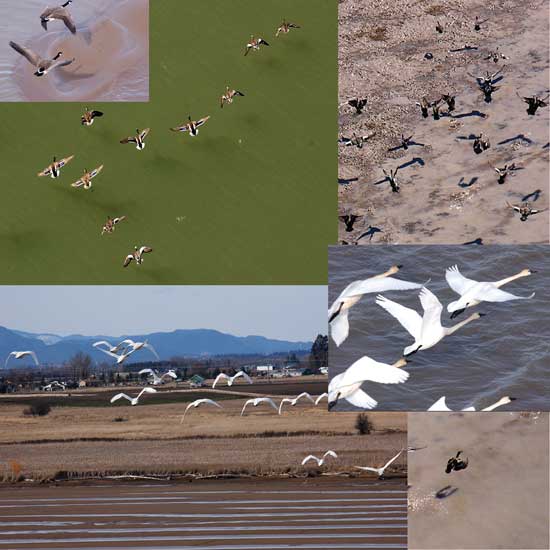 |
| Figure 2.64: Migrating birds. Source: Karen Nichols, 2006/2007 |
Even the mountains themselves play a role in the migration of birds, as the rising and falling air currents above the Rockies offer great currents to birds of prey, while low mountain passes offer excellent passage to waterfowl flocks moving between the Pacific Coast and the Great Plains.
The Ninepipe and Pablo National Wildlife Refuges on the Flathead Indian Reservation in the Mission Valley function as excellent breeding grounds for native bird populations. Their combination of wetlands, grasslands and shrub cover support waterfowl species, including Canada goose (Branta canadensis), American wigeon (Anas americana), gadwall (A. strepera), mallard (A. platyrhynchos), northern shoveler (A. clypeata), northern pintail, redhead duck (Aythya Americana), and ruddy duck (Oxyura jamaicensis).
The cottonwoods, hawthorn and willows common in these areas provide nesting and foraging for American robins (Turdus migratorius), warbling vireos (Vireo gilvus), yellow-rumped warblers (Dendroica coronata), and yellow warblers (Dendroica petechia). Great blue herons (Ardea herodias), double-crested cormorants (Phalacrocorax auritus), red-necked grebes (Podiceps grisegena) and the valley’s only nesting colony of western grebes (Aechmophorous occidentalis) also make Ninepipe their home. Both refuges have irrigation and flood control reservoirs managed under the authority of the National Bison Range Complex through a cooperative effort of the U.S. Fish & Wildlife Service and the Confederated Salish and Kootenai Tribes. The refuges provide important habitat to these and other colonial and island-nesting waterbirds (e.g. gulls, terns).
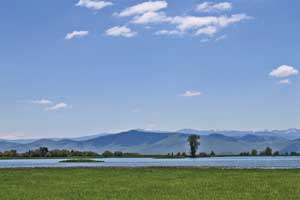 |
| Figure 2.65: Ninepipe and Pablo National Wildlife Refuge Complex. Source: Lori Curtis |
Pablo National Wildlife Refuge is also a core area for a trumpeter swan (Cygnus buccinator) reintroduction program by the Confederated Salish and Kootenai Tribes. Ospreys (Pandion haliaetus) nest on platforms on the southern shore of Ninepipe, while bald eagles (Haliaeetus leucocephalus) fledge young most years from nests at each refuge. The Flathead Watershed as a whole supports more than half of the 400+ known bald eagle nesting territories in the state.
Waterton Lakes National Park
Over 255 species of birds have been recorded in Waterton Lakes National Park, though only 37 are year-round resident species. The Waterton Lakes are a key rest stop for migrating ducks, geese, and swans, particularly in the fall. Large rafts of American coots (Fulica americana) and flocks of cinnamon teal (Anas cyanoptera), hooded mergansers (Lophodytes cucullatus), northern shovelers, and tundra swans make their way to the lakes. Bald eagles, Canada Geese, and sandhill cranes (Grus canadensis) nest in the park. Over half of the park’s 60 native species of songbirds nest in the wooded areas, particularly in the montane forests.
Red-breasted nuthatches, boreal chickadees (Poecile hudsonicus), and American three-toed woodpeckers (Picoides dorsalis) nest in decaying stumps in the subalpine areas. Brewer’s (timberline) sparrow (Spizella breweri), gray-crowned rosy finch (Leucosticte tephrocotis), rock wren (Salpinctes obsoletus), and white-tailed ptarmigan (Lagopus leucura) are some of the few birds that can survive the short, harsh summers of the alpine zone here.
Behind the waterfalls of the Waterton-Glacier Park complex are found the nests of one of North America’s most enigmatic and least known birds, the black swift (Cyseloides niger). One of the world’s “cloud” or “storm swifts, ” this species returns to the same site year after year to raise a single chick in a mossy nest, often directly behind the cascade of a waterfall, and always out of the sun’s reach. For more than a month, the hatchling rests in near suspended animation (torpor) while waiting for its parents to return with food. These birds leave their high elevation nests to fly far afield in search of aerial insect swarms. Often on the stormiest days, black swifts can be seen over the largest lakes in the watershed. Because of their narrow habitat needs, site fidelity and low productivity, the black swift is considered to be one of the continent’s least resilient species in the face of climate change.
Waterfowl Production Areas:
Prairie Jewels of the Refuge System
There are nine Waterfowl Production Areas (WPAs) in Lake County and five in Flathead County ranging from 28 to 2,370 acres (11 to 960 hectares). These U.S. Fish and Wildlife Service-managed WPA’s are part of the National Wildlife Refuge System. They include wetlands and grasslands that are set aside to provide habitat for waterfowl, shorebirds, and grassland birds, as well as other wildlife. They are open to the public for wildlife education, viewing, photography, and hunting. These public lands became part of the National Wildlife Refuge System in 1966 through the National Wildlife Refuge Administration Act which was established by President Theodore Roosevelt in 1903.
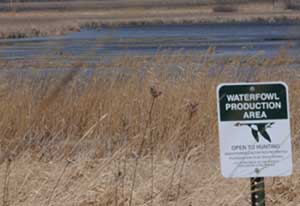 |
| Figure 2.66: Waterfowl Protection Area. Source: Lori Curtis |
The wetland habitats found in the WPAs provide nesting and brood-rearing habitat for such waterfowl species as the American wigeon, blue winged and green-winged teal (Anas discors, A. carolinensis), Canada goose, mallard, northern pintail, northern shoveler, and lesser scaup (Aythya affinis). They also support nesting northern harriers (Circus cyaneus) and short-eared owls (Otus asio), and provide important wintering areas for northern goshawks (Accipiter gentilis), red-tailed hawks (Buteo jamaicensis), and rough-legged hawks (B. lagopus).
Migratory shorebirds such as the American avocet (Recurvirostra americana), Black-necked Stilt (Himantopus mexicanus), Killdeer (Charadrius vociferous), and Wilson’s phalarope (Phalaropus tricolor), also use the WPAs for nesting. Upland WPAs supply perennial cover for gray partridges and ring-necked pheasants and provide nesting habitat for western meadowlarks, Savannah and clay-colored sparrows. Badgers, meadow voles, mink, muskrats, porcupines, and striped skunks also inhabit the WPAs.
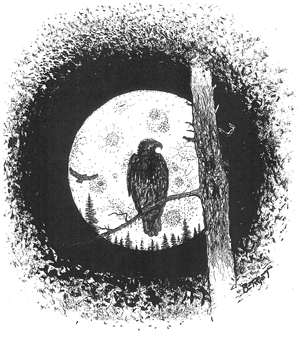 |
| Figure 2.67: Bald eagle. Source: Todd Berget |
The bald eagle (H. leucocephalus) is a magnificent bird of prey that appears to rule the sky with its five to seven foot (1.5 to 2.1 m) wingspan, two to four foot (61 cm to 1.2 m) body length, and 5 to 15 pound (2.27 to 6.8 kg) body weight. Fossil remains of eagles have been found dating as far back as 25 million years ago. Eagles have long been honored by ancient and native peoples. Some Native Americans today continue to appreciate the bald eagle as sacred and powerful. Long-practiced rituals and dances involving eagle feathers and symbolism are designed to insure the continued harmony between all living creatures and to honor the eagle as a spiritual messenger between gods and human cultures.
In 1782, the Second Continental Congress officially adopted the bald eagle as the national symbol for the United States representing the country’s strength, power, and freedom. The species was listed as endangered in Montana in 1978 after years of habitat destruction, contamination, and hunting. After its encouraging comeback from the edge of distinction, the bald eagle was downlisted to threatened in 1995. Today, the bald eagle has been removed from the endangered species list altogether, and the species nests in all 50 states. Montana alone supports more than 400 nesting pairs.
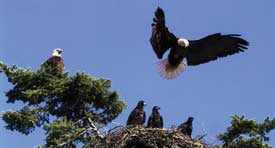 |
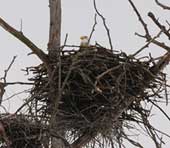 |
| Figure 2.68: Bald eagles with fledglings. Source: National Park Service |
Figure 2.69: Eagles nest. Source: National Park Service |
In the Flathead Watershed, bald eagles occupy territories along rivers, lakes, and reservoirs, preferring a diet of fish. Here, both resident and migratory eagles find critical winter foraging habitat. They are skilled, opportunistic feeders that scavenge as well as they hunt. They build some of the largest nests of any bird in the world and return to them for several years. Nests are built primarily of accumulated twigs and sticks, to which they add material upon their annual return. These nests can be as large as 4 to 10 feet (1.2 to 3 m) in diameter and generally weigh hundreds of pounds, with some reaching up to two tons (1.8 metric tons).
Another Species of Concern, the common loon (Gavia immer) spends its summers on lakes throughout the Flathead Watershed. This large, strictly aquatic bird ranges from 28 to 36 inches (71 to 92 cm) in length, with a wingspan of up to 58 inches (147 cm). A glossy green-black head, “necklace” of small white bars, and large white markings on the back and folded wings make them easy to identify in the field, as does their haunting, yodeling cry.
 |
| Figure 2.70: Common loon with chick. Source: Daniel Poleschook, Jr. & Ginger R. Gumm |
These birds migrate to the watershed in early- to mid-March seeking lakes that are at least 13 acres (5.3 hectares) and that have both nesting and nursery areas. They show some degree of site fidelity, and seem to prefer returning to the lakes where they have bred before, or close to the lake on which they were hatched. This trait means that maintaining the population in the watershed will require protecting and managing those lakes known to support nesting pairs, as once a territory is abandoned, the species is very slow to recolonize an area.
They prefer small islands for nesting, but are also known to use heavily vegetated shoreline areas, particularly those with fingers of land jutting into the water. It is estimated that there are about 200 current and potential nesting territories in Montana, most in this watershed. They are opportunistic feeders, eating mainly fish, but also amphibians, insects, mollusks, and vegetation. The common loon’s feet are located far to the rear of its body making it clumsy on land, but very efficient at swimming underwater.

